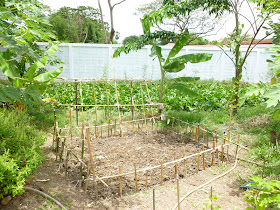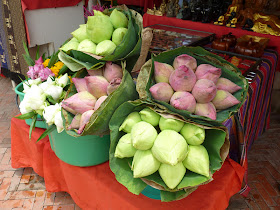Sadly, there are few intact Buddha statues and only a handful of what was once 400 temples have been restored. However, it is still possible to get a real sense of how magnificent Ayuthaya must have been in its prime.
This Buddha head in the tight embrace of a banyan tree is one of the most enduring icons of Ayuthaya.
 |
| Many of the buildings are on quite a strong lean and would definitely not survive volcanic and seismic activity, such as Indonesia experiences in Jogya, near the temples of Pranbaran and Borobudur. |
 |
| Some of the smaller statues at Wat Na Phra, one of the few temples to survive, because the Burmese army used it as their base. |
 |
| This green sandstone Buddha in a shrine adjoiing Wat Na Phra Meru is Sri Lankan and 1500 years old. |
 |
| Making offerings at the entrance of the temple housing the Sri Lankan Buddha. |
 |
| In the same entry as above, a trio of adenium. |
 |
| Detail of a niche on the exterior of the main building Wat Na Phra Meru |
 |
| The reclining Buddha (Budhasaiyart) at Wat Lokayasutha |
 |
| Lotus offerings to the reclining Buddha |
 |
| A nearby vegetable patch |
 |
| More lotus for sale as offerings at the adjoining stalls. |












Marisa, I thoroughly enjoyed this post. I learned so much, and I felt as if I were right there with you. Such a beautiful place with its rich cultural history.
ReplyDeleteThanks for posting.
Thanks, Virginia. It was a wonderful spot to visit. I have been a very lucky girl with my travels this year.
ReplyDelete